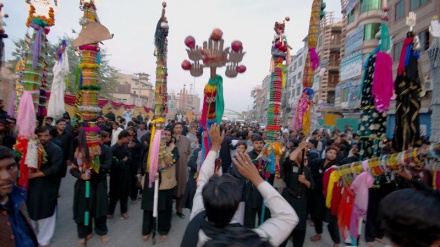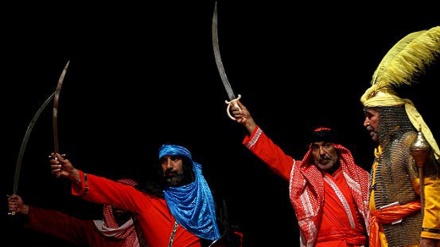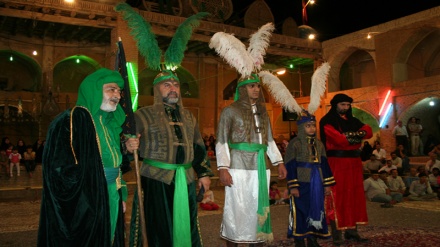Muharram mourning traditions in different lands - 22
Welcome to the 22nd part of the 40-plus episodes of a new and interesting series titled “Muharram Mourning Traditions in Different Lands” that we started broadcasting as of October 15 on a daily basis, to commemorate the heartrending tragedy of Karbala, and the martyrdom of Imam Husain (PBUH), the grandson of Prophet Mohammad (Blessings of God upon him and his progeny).
In this series, which delves into the various mourning traditions associated with the Immortal Epic of Ashura in various lands, we look at the history of mourning for Imam Husain (PBUH).
Yesterday we said, how the Father of the Islamic Revolution, Imam Khomeini (God bless him), led the Muslim people of Iran to victory over the Pahlavi regime, by awakening their conscience. As we also said, according to Imam Khomeini, the genesis and continuity of the Islamic Revolution owes to Ashura and the lesson Imam Husain (AS) has taught to humanity. He remarks: “we all should be aware that our Revolution may not result in triumph if was not the uprising of the Master of Martyrs Imam Husain (AS); The Islamic Revolution is a light of Ashura and its Divine revolution.”
Thus, inspired by the movement of the Chief of Martyrs and by the epic of Ashura, as the greatest religious-political treasure of Islam, Imam Khomeini sought to revive Islam in Iran and the region. When the US imposed the 8-year war through Saddam, the Iranian people, inspired by the Battle of Karbala, rallied to the call of Imam Khomeini, to mobilize the defence of faith and the country. It was attachment to the values of Ashura that made the Iranian Muslims emerge triumphant in the war which almost the whole world was waging against the Islamic Republic of Iran. We recall vivid scenes from those days when soldiers in the bunkers would normally turn their faces towards Karbala in Iraq to recite the Ziyarat-e Warres or the Ziyarat-e Ashura of Imam Husain (AS). They would recite the elegies, beat their chests in grief, shed tears for the sufferings of the Prophet’s Ahl al-Bayt in order to uplift their morale and determination. These were the values that defeated the Ba'thist enemy and its cowardly backers, especially the US, whose satanic plots against Islamic Iran, including sanctions and threats, have come to naught. By enacting epics on the warfronts, the Muslim combatants of Iran inculcated the spirit of resistance in the Lebanese, Palestinian, and people of other countries, such as Afghanistan, Pakistan, Iraq, Yemen, Bahrain, and Nigeria, who are definitely influenced by the movement of the Prophet's grandson.
The phrase “Every day is Ashura and every place is Karbala” signifies that the battle between good and evil is to go on and isn’t limited to any time or place, and that this battle is linked to the ones before, forming a single chain. The incident of Ashura is one of the clearest links of this very long chain. Good and evil are always face to face, and thus, being careless in this battle is considered turning away from religion. Imam Khomeini, as the Founder of the Islamic Republic, was indeed a true follower of Imam Husain (AS). He fought the oppressors of his time, and used to refer to this famous statement “Every day is Ashura and Every place is Karbala”, as “The Great Statement”. He used to stress the keeping alive the message of Ashura by putting it into practice. He would say: “This statement is a great one…our nation must always pay attention to the fact that even today is Ashura and that we must stand up against oppression and that we are currently in Karbala and must act according to it, Karbala isn’t limited to a specific land. The incident of Karbala isn’t limited to a group of seventy-something people in the land of Karbala, all lands must play the same role as Karbala did.”
Imam Khomeini considered the uprising of Imam Husain (AS) the foundation of his movement. He would say: “What Imam Husain (AS) did, the idea that he had, the way he showed, and his victory after his martyrdom, is indeed the victory of Islam. The responsibility is that the oppressed, no matter how little in number, must stand up like Imam Husain (AS) against their oppressors, regardless of their number”.
During the imposed war on Iran, the Great Leader of the Revolution stated: “Although the Battle of Ashura was the shortest one in terms of time (that is, half a day), it is the longest battle between good and evil as time progresses and its impact on subsequent centuries and places. In other words, the Bbattle of Karbala is still going on and the epic of Ashura is continuous.”
In other words, as Imam Husain (AS) is the inheritor and successor (wareth) of all divine messenger, especially the leading ones such as Adam, Noah, Abraham, Moses, Jesus, and Prophet Mohammad (peace and blessings of Allah be upon all of them). The followers of Imam Husain (AS) are the inheritors and successors of the red line of Jihad and Shahadah (martyrdom) and will never put down the flag of Karbala – whether in Iran, in Iraq, in Bahrain, in Hijaz, in Yemen, in Syria, in Nigeria, in the Republic of Azerbaijan, in Pakistan, in Afghanistan, and all over the world.
In view of this fact, the mourning ceremonies for the Immortal Martyr of Karbala, and the way different nations observe them in their traditional ways, are indeed part of the grand movement to keep alive the values of freedom, justice, moral values, and etc. The Tragedy of Karbala happened almost 14 centuries ago, but its impact is transcendental. It gives an eternal lesson in human sacrifice and dignity and teaches one to wage war against the Yazids of all times. That is why this saga, despite being repeated time and again, has not become old. Restrictions imposed by rulers, exigencies of circumstances, and fatwas of blasphemy and innovation have failed to reduce the tragic importance and the truth of Karbala, which every year in the months of Muharam and Safar, renew the allegiance of the believers through the life-inspiring mourning ceremonies.
MD/AS/ME


